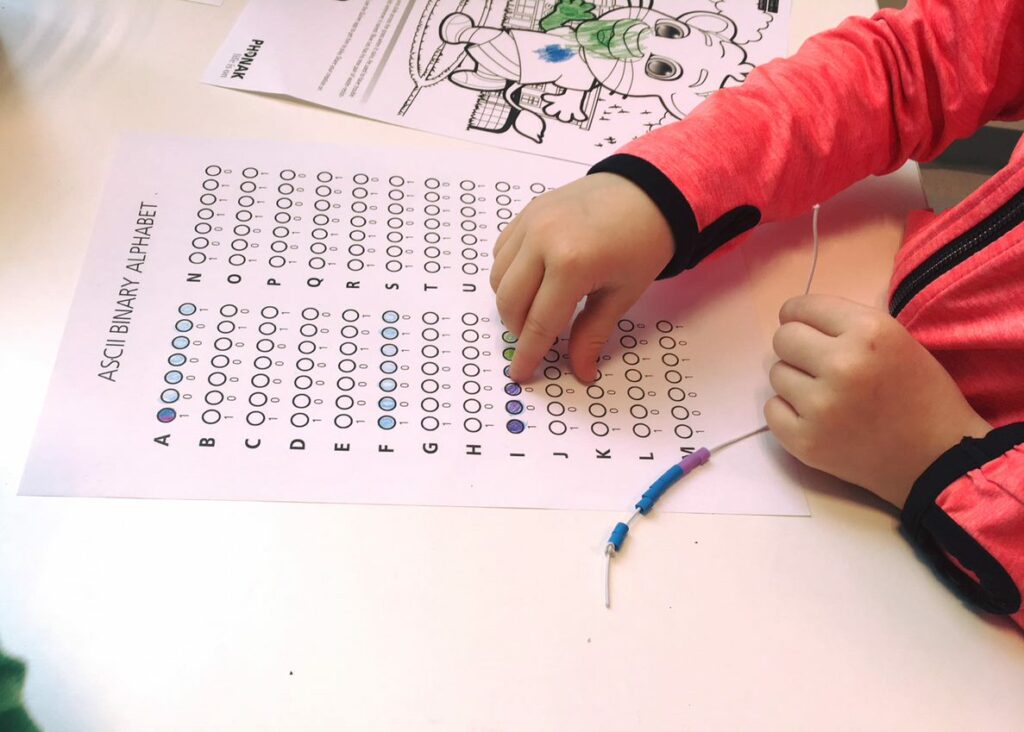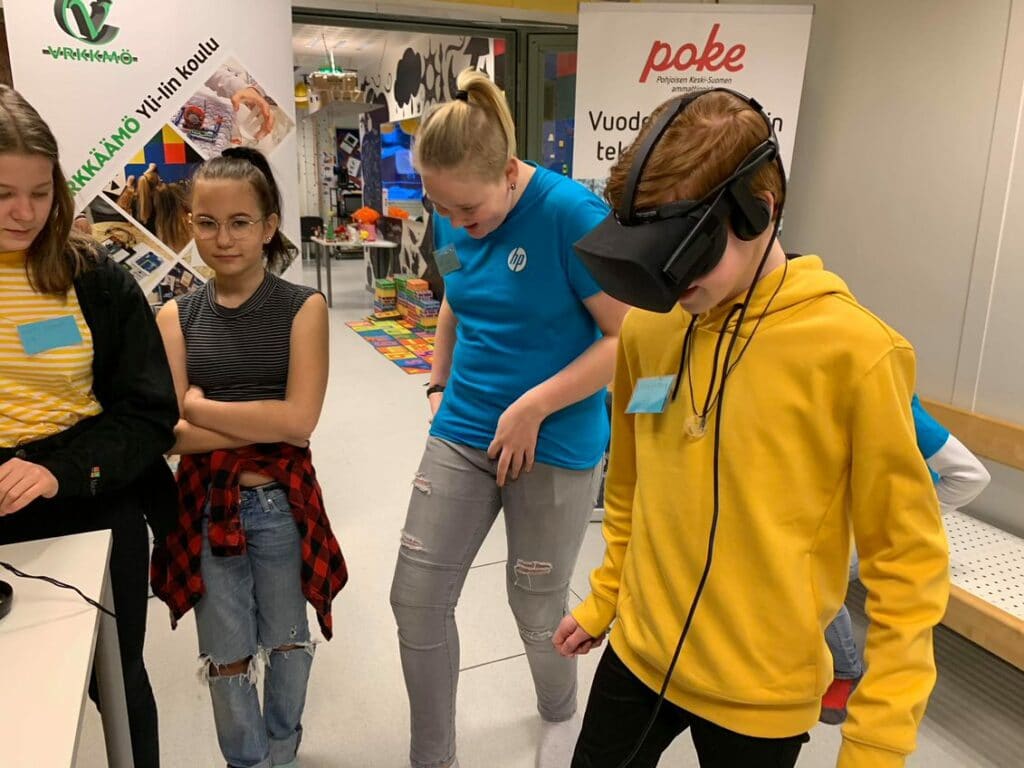
What is STEAM education? STEAM – science, technology, engineering, arts, and mathematics – means combining cross-curricular subjects and technology into wide-ranging meaningful entities. Its goal is to show students that in real-life situations knowledge is used across the fields of study. STEAM is a way to examine and implement the curriculum and build interdisciplinary learning modules.
STEAM education in Finland was reinforced with the new national core curriculum in 2016. STEAM education in Finland emphasizes teaching of cross-curricular subjects and addressing 21st century skills or transversal competencies as they are called in the national core curriculum.

Get to know STEAM learning environment
One of the great examples of Finnish STEAM education practices is Yli-Ii Comprehensive School in Northern Finland. The school is located in rural area, 50 kilometres from the city centre of Oulu. The school has about 300 students and a staff of 30. You can even find reindeers next to the school!
Like all schools in Finland, Yli-Ii’s school is publicly funded. In addition to basic education grades 1–9 there are pre-primary classes, groups for children with special needs, and a JOPO (Flexible Basic Education) class for students who are lacking school motivation and are in the fear of dropping out.
Yli-Ii’s school has created a STEAM learning environment called Värkkäämö. The idea of Värkkäämö is to combine the best parts of a “makerspace” culture. A makerspace is a collaborative workspace where you can make, learn, explore, share, and use high-technology besides other tools. The aim is to enhance students’ work-life skills such as communication, cooperation, creativity, critical thinking, and the use of technology. The Värkkäämö environment is equipped with modern tools like a laser cutter, a vinyl cutter, a CNC-carver, robotics, and 3D-printers.

In Yli-Ii’s school art is an important part of STEM education adding creativity to STEAM projects. Art also inspires such students to participate in a STEAM project who would not necessarily be interested in STEM project solely. Besides, art has many positive effects for learning: art helps improve emotional growth, social development, academic performance, cultural awareness, decision-making, inventiveness, language development, motor skills, visual learning etc.
The underlying idea in Värkkäämö is to have a learning community with modern teaching and learning methods, cooperation of teachers, 21st century skills, and the use of technology in a modern learning environment. The basis of the Värkkäämö pedagogy is student-centered learning in which the goal is to promote each learner’s learning process. Interdisciplinary learning modules are designed and implemented according to the curriculum and students’ interests. Activities are designed so that they support students’ competence, autonomy, and involvement. Co-operation between students and teachers is crucial.

Students´ role is crucial
In Yli-Ii school, students have an important role in designing STEAM education. In the first place, they have been designing the school’s STEAM working space Värkkäämö together with their teachers and helped to build it. More importantly, students also participate in designing the STEAM learning modules. Students have a lot of freedom to accommodate the way they want to study and learn during the STEAM projects: students can choose their working methods, platforms, technology, different ways to accomplish their learning tasks and the digital devices they use, how to show what they have learned etc. Most of the time classroom doors are open and students have the freedom to choose their most suitable working space and project. Change of roles motivates students, and they clearly like to provide ideas to their teachers and assist other students. Discovering their own strengths also builds up their self-esteem.
Most of the projects and prototypes done in Värkkäämö are based on real-world problem-solving like everyday automation. In Yli-Ii school, STEAM education is a collaborative effort. For example, teachers of special education, art, biology, and geography work in a collaborative way. They share their projects, lessons, ideas, and knowledge so that all of them can join in on the same project. Classes can be mixed by subject and grade and the students’ varying ages is not an issue. Usually, students work in small groups and their input and goals are unique for each group. Heterogenic skills and knowledge of the students benefit everybody’s learning. Students help their peers, and in many cases, they help and assist the teachers as well.
Working in teacher teams
Working in teacher teams has many advanteges when implementing STEAM education. It allows teachers to share their own expertise and at the same time enjoy the expertise of a colleague. Together, teachers can reach a greater level of pedagogical expertise, technological know-how, and professional development.

The teachers in Yli-Ii school have found many phenomena that fit perfectly for cross-curricular studies. For example, it is easy to combine subjects like geography, physics, mathematics, and art for studying renewable energy or sustainable development. Here is one example of their cross-curricular projects: Students will design and build a working miniature windmill that produces enough electricity to power up light-emitting diodes (LEDs). In this project, a physics teacher has the knowledge how to build a generator or how to combine LEDs and a resistor. The art teacher helps with the design and materials. The geography teachers share their knowledge how to study the effects of renewable and nonrenewable energy etc.
Benefits for students and teachers
The overall experiences of this STEAM learning environment have been inspirational and encouraging. Students are more motivated, their responsibility and commitment to the school has grown, and their social skills have improved. Overall, student well-being has increased after STEAM education was introduced in the school. Furthermore, STEAM education seems to improves students’ thinking skills and abilities to think logically. The students are more ready to face real-life challenges, such as postgraduate studies and work with technology.
Students’ school motivation has clearly increased after participating in STEAM projects. This can be seen regardless of gender. In addition, students’ self-esteem has increased significantly after a successful STEAM project. Students are proud of their achievements and themselves. When they present their work to other teachers or guests of the school, their self-esteem boosts even further. STEAM education seems to prevent the exclusion of students and encourages the students to be more socially involved.

There is impact on learning outcomes as well. In STEAM projects, students have varying ways to show their knowledge instead of just being tested traditionally. This enables all kinds of learners to choose the most proper practices and devices to do their learning tasks and to demonstrate their skills. There are success stories especially with students who have low motivation or severe learning disabilities.
Teachers’ have also noticed improvement in students’ social and soft skills. When students work together on a STEAM project, they learn coworking and collaboration at the same time. In addition, STEAM projects enhance creativity, problem-solving, and other important 21st century skills. It is too early to tell if students of Yli-Ii will choose more STEAM or technology-related careers. But the awareness and enthusiasm about STEAM subjects have clearly increased.
It is not only the students who have benefitted of STEAM education at Yli-Ii’s school. Many teachers have become more motivated to learn new things and improve their own work. STEAM education has boosted the working culture and raised the self-esteem of the community.

Värkkäämö has gained both national and international recognition. Värkkäämö has had many visitors from Finland and abroad who have wanted to familiarize themselves with their pedagogical model. Yli-Ii’s school is a living proof that you can have world-class education in remote settings as well. The dedicated and talented staff and their driving vision has made this adventure come true.
We hope this gave you some inspiration what is STEAM education. If you want to learn more about Finnish STEM and STEAM education, please check the online course S1 Introduction to Finnish STEAM education . If you are interested in adding art to your STEM projects, you might enjoy S2 Outdoor Exercises and Art in STEAM projects. And if you want to know more about STEM and sustainable development in education, don’t miss an online course S8 Sustainable Development in Education.
Read more:
Hiltunen, E, Miettunen, J, Sillanpää, V, & Sälevä, S.: On the Trail of Learning—Science, Technology, Engineering, Arts, and Mathematics in Finnish Basic Education.

